New Perspectives in the Fight Against Multidrug-Resistant Bacteria: The Potential of Endolysin Biocomposites
Abstract
1. Introduction
2. Generalities of Endolysins
2.1. Structure of Endolysins
2.2. Classification of Endolysins
2.3. Endolysins and Their Conceptualization as Antibacterial
2.4. Individual and Combined Efficacy Against Gram-Positive and Gram-Negative Bacteria
| Endolisyn | Description | Treatment | Activity Spectrum | Dose (µg/mL) | Specifications | References |
|---|---|---|---|---|---|---|
| Strategy 1: Identification of endolysins with intrinsic OM-passing capabilities | ||||||
| LysAB2 | Globular with a highly cationic α-helix in the C-terminal region | – | A. baumannii E. coli S. aureus (+) S. sanguis (+) | 500 |
| [36] |
| PlyF307 | Globular and highly cationic in the C-terminal region | – | A. baumannii | 100 |
| [37] |
| 80α, phi11, LysK | Modulate with CHAP domain and amidase | – | Staphylococcus spp. (+) | 200 |
| [20] |
| ΦCP39O and ΦCP26F | Modulate with amidase domain | – | C. perfringens (+) | – |
| [17] |
| LysPA26 | Globular with a single lysozyme domain | – | P. aeruginosa K. pneumonia A. baumannii E. coli | 500 |
| [38] |
| KP27 | Globular with carboxypeptidase activity | – | P. aeruginosa K. pneumonia | 400 |
| [39] |
| PlyE146 | Globular with a muramidase activity and highly cationic C-terminal domain | – | A. baumannii P. aeruginosa E. coli | 400 |
| [40] |
| PlyGVE2CpCWB | Modulate with amidase domain and a C-terminal CBD | – | C. perfringens (+) | 2000 |
| [18] |
| AcLys | Globular with a C-terminal α-helix and muramidase activity | – | A. baumannii P. aeruginosa K. pneumonia E. coli | 50–100 |
| [41] |
| Ply6A3 | Globular with muramidase activity | – | A. baumannii K. pneumonia E. coli E. faecium (+) S. aureus (+) | – |
| [42] |
| KZ144 | Modulate with lytic transglycosidase activity | – | P. putida P. fluorescens E. coli S. typhimurium | – |
| [14] |
| PlyLM | Modulate with amidase activity | – | Listeria monocytogenes (+) | – |
| [19] |
| Strategy 2: Application of OMPs and other treatments to permeabilize the OM | ||||||
| SPN9CC | Globular with transmembrane helix at the N-terminus | 1–5 mM EDTA | E. coli | 300 |
| [43] |
| GP110 | Modulate with an N-terminal PBD and a C-terminal EAD. | 0.5 mM EDTA | P. aeruginosa S. typhimurium | 72.5 |
| [44] |
| Ply17 | Modulate with an N-terminal PBD and a C-terminal EAD | 0.1–5 mM EDTA | P. aeruginosa E. coli | 1000 |
| [45] |
| LysB4 | Modulate with endopeptidase activity | 0.1 M EDTA | – | 5 |
| [21] |
| Lys394 | Globular with muramidase activity | Poly-L-arginine (5–15 kDa) 0–1 mM EDTA PGLa peptide | E. coli | – |
| [46] |
| LysABP-01 | Globular with muramidase activity | Colistin | A. baumannii P. aeruginosa E. coli | 500 |
| [47] |
| ABgp46 | Globular with acetylmuramidase activity | Citric acid (3.65 mM) Malic acid (4.55 mM) EDTA (0.5 mM) | A. baumannii P. aeruginosa S. typhimurium | 46.2 |
| [48] |
| Lysep3 | Globular with lysozyme activity | EDTA 25 mM | P. aeruginosa E. coli | – |
| [22] |
| Strategy 3: Endolysin design to promote endolysin uptake through the OM | ||||||
| Cpl-7S | 15th amino acid substituted in CBD for Cpl-7 derived from pneumococcal phage Cp-7 | 0.01% carvacrol | S. pneumonia (+) S. pyogenes (+) E. coli P. putida | 5 |
| [49] |
| Artilisyn | Fusing PCNP at the N-terminus to two modular lysines (OBPgp279 and PVP-SE1gp146) | 0.5 mM EDTA | P. aeruginosa A. baumannii E. coli | 53.3 |
| [50] |
| Strategy 4: Application of endolysins in carrier systems | ||||||
| 4Lyz-CBM | Fusion of a cellulose-binding module (CBM) to globular T4Lyz with amphipathic α-helix and muramidase activity | Pretreated with chloroform | E. Coli P. mendocina M. lysodeikticus (+) | 200 |
| [51] |
| BSP16Lys | Cationically charged BSP16Lys encapsulated liposome composed of DPPC, cholesterol, and hexadecylamine | – | S. typhimurium E. Coli | 94.5 |
| [52] |
2.5. Effect of Abiotic Factors on Endolysins
2.6. Commercial Endolysins
3. Biocomposites and Colonic Fermentation: The Key to Combating Gastrointestinal Diseases
3.1. Definition of Biocomposite and Its Potential Antimicrobial Activity
3.2. Colonic Fermentation and Gastrointestinal Health
4. Biocomposites: Novel Strategy for the Administration of Endolysins
4.1. Alginate Oligosaccharides as an Important Wall Element
4.2. Endolysin Carrier Potential: Modified Cellulose
4.3. Formation of the Biocomposite: Endolysin to Choose
5. Current Trends of Applied Endolysins for Gastrointestinal Diseases
5.1. Current Trends in the Use of Endolysins as Treatment for Gastrointestinal Diseases
5.2. Current Trends in Biocomposites Directed at Gram-Positive and -Negative Bacteria of Clinical and Nutritional Interest
6. Challenges and Opportunities in the Application of Antibacterial Biocomposites for Gastrointestinal Diseases
7. Conclusions
Author Contributions
Funding
Institutional Review Board Statement
Informed Consent Statement
Data Availability Statement
Acknowledgments
Conflicts of Interest
References
- Kongkham, B.; Prabakaran, D.; Puttaswamy, H. Opportunities and challenges in managing antibiotic resistance in bacteria using plant secondary metabolites. Fitoterapia 2020, 147, 104762. [Google Scholar] [CrossRef] [PubMed]
- Jindal, A.K.; Pandya, K.; Khan, I.D. Antimicrobial resistance: A public health challenge. Med. J. Armed Forces India 2015, 71, 178–181. [Google Scholar] [CrossRef] [PubMed]
- Alós, J.-I. Resistencia bacteriana a los antibióticos: Una crisis global. Enferm. Infecc. Microbiol. Clin. 2015, 33, 692–699. [Google Scholar] [CrossRef]
- Whatmore, A.M.; Reed, R.H. Determination of turgor pressure in Bacillus subtilis: A possible role for K+ in turgor regulation. J. Gen. Microbiol. 1990, 136, 2521–2526. [Google Scholar] [CrossRef]
- Calero-Cáceres, W.; Ye, M.; Balcázar, J.L. Bacteriophages as Environmental Reservoirs of Antibiotic Resistance. Trends Microbiol. 2019, 27, 570–577. [Google Scholar] [CrossRef] [PubMed]
- Rahman, M.U.; Wang, W.; Sun, Q.; Shah, J.A.; Li, C.; Sun, Y.; Li, Y.; Zhang, B.; Chen, W.; Wang, S. Endolysin, a Promising Solution against Antimicrobial Resistance. Antibiotics 2021, 10, 1277. [Google Scholar] [CrossRef]
- Gerstmans, H.; Criel, B.; Briers, Y. Synthetic biology of modular endolysins. Biotechnol. Adv. 2018, 36, 624–640. [Google Scholar] [CrossRef]
- Camacho-González, C.E.; Cardona-Félix, C.S.; Zamora-Gasga, V.; Pérez-Larios, A.; Sánchez-Burgos, J.A. Biofunctionalization of Endolysins with Oligosacharides: Formulation of Therapeutic Agents to Combat Multi-Resistant Bacteria and Potential Strategies for Their Application. Polysaccharides 2022, 3, 306–325. [Google Scholar] [CrossRef]
- SUIVE/DGE/SSA. Veinte Principales Causas de Enfermedad Nacional en México. Ciudad de México; 2022. Available online: https://epidemiologia.salud.gob.mx/anuario/html/morbilidad_nacional.html (accessed on 5 February 2025).
- Gondil, V.S.; Harjai, K.; Chhibber, S. Endolysins as emerging alternative therapeutic agents to counter drug-resistant infections. Int. J. Antimicrob. Agents 2020, 55, 105844. [Google Scholar] [CrossRef]
- Young, R. Bacteriophage lysis: Mechanism and regulation. Microbiol. Rev. 1992, 56, 430–481. [Google Scholar] [CrossRef]
- Wu, X.S.; Wang, N. Synthesis, characterization, biodegradation, and drug delivery application of biodegradable lactic/glycolic acid polymers. Part II: Biodegradation. J. Biomater. Sci. Polym. Ed. 2001, 12, 21–34. [Google Scholar] [CrossRef]
- Loessner, M.J.; Kramer, K.; Ebel, F.; Scherer, S. C-terminal domains of Listeria monocytogenes bacteriophage murein hydrolases determine specific recognition and high-affinity binding to bacterial cell wall carbohydrates. Mol. Microbiol. 2002, 44, 335–349. [Google Scholar] [CrossRef]
- Briers, Y.; Volckaert, G.; Cornelissen, A.; Lagaert, S.; Michiels, C.W.; Hertveldt, K.; Lavigne, R. Muralytic activity and modular structure of the endolysins of Pseudomonas aeruginosa bacteriophages φKZ and ELs. Mol. Microbiol. 2007, 65, 1334–1344. [Google Scholar] [CrossRef]
- Schleifer, K.H.; Kandler, O. Peptidoglycan types of bacterial cell walls and their taxonomic implications. Bacteriol. Rev. 1972, 36, 407–477. [Google Scholar] [CrossRef]
- Nelson, D.C.; Schmelcher, M.; Rodriguez-Rubio, L.; Klumpp, J.; Pritchard, D.G.; Dong, S.; Donovan, D.M. Endolysins as Antimicrobials. Adv. Virus Res. 2012, 83, 299–365. [Google Scholar]
- Jado, I. Phage lytic enzymes as therapy for antibiotic-resistant Streptococcus pneumoniae infection in a murine sepsis model. J. Antimicrob. Chemother. 2003, 52, 967–973. [Google Scholar] [CrossRef]
- Gutiérrez, D.; Ruas-Madiedo, P.; Martínez, B.; Rodríguez, A.; García, P. Effective Removal of Staphylococcal Biofilms by the Endolysin LysH5. PLoS ONE 2014, 9, e107307. [Google Scholar] [CrossRef]
- Briers, Y.; Walmagh, M.; Grymonprez, B.; Biebl, M.; Pirnay, J.-P.; Defraine, V.; Michiels, J.; Cenens, W.; Aertsen, A.; Miller, S.; et al. Art-175 Is a Highly Efficient Antibacterial against Multidrug-Resistant Strains and Persisters of Pseudomonas aeruginosa. Antimicrob. Agents Chemother. 2014, 58, 3774–3784. [Google Scholar] [CrossRef]
- Becker, S.C.; Roach, D.R.; Chauhan, V.S.; Shen, Y.; Foster-Frey, J.; Powell, A.M.; Bauchan, G.; Lease, R.A.; Mohammadi, H.; Harty, W.J.; et al. Triple-acting Lytic Enzyme Treatment of Drug-Resistant and Intracellular Staphylococcus aureus. Sci. Rep. 2016, 6, 25063. [Google Scholar] [CrossRef]
- Fernández, L.; González, S.; Campelo, A.B.; Martínez, B.; Rodríguez, A.; García, P. Downregulation of Autolysin-Encoding Genes by Phage-Derived Lytic Proteins Inhibits Biofilm Formation in Staphylococcus aureus. Antimicrob. Agents Chemother. 2017, 61, e02724-16. [Google Scholar] [CrossRef]
- Witzenrath, M.; Schmeck, B.; Doehn, J.M.; Tschernig, T.; Zahlten, J.; Loeffler, J.M.; Zemlin, M.; Müller, H.; Gutbier, B.; Schütte, H.; et al. Systemic use of the endolysin Cpl-1 rescues mice with fatal pneumococcal pneumonia*. Crit. Care Med. 2009, 37, 642–649. [Google Scholar] [CrossRef]
- Zhang, L.; Li, D.; Li, X.; Hu, L.; Cheng, M.; Xia, F.; Gong, P.; Wang, B.; Ge, J.; Zhang, H.; et al. LysGH15 kills Staphylococcus aureus without being affected by the humoral immune response or inducing inflammation. Sci. Rep. 2016, 6, 29344. [Google Scholar] [CrossRef]
- Djurkovic, S.; Loeffler, J.M.; Fischetti, V.A. Synergistic Killing of Streptococcus pneumoniae with the Bacteriophage Lytic Enzyme Cpl-1 and Penicillin or Gentamicin Depends on the Level of Penicillin Resistance. Antimicrob. Agents Chemother. 2005, 49, 1225–1228. [Google Scholar] [CrossRef]
- Shen, Y.; Barros, M.; Vennemann, T.; Gallagher, D.T.; Yin, Y.; Linden, S.B.; Heselpoth, R.D.; Spencer, D.J.; Donovan, D.M.; Moult, J.; et al. A bacteriophage endolysin that eliminates intracellular streptococci. Elife 2016, 5, e13152. [Google Scholar] [CrossRef]
- Zermeño-Cervantes, L.A.; González-Acosta, B.; Martínez-Díaz, S.F.; Cardona-Félix, C.S. Antibacterial proteins and peptides as potential treatment in aquaculture: Current status and perspectives on delivery. Rev. Aquac. 2020, 12, 1135–1156. [Google Scholar] [CrossRef]
- Breijyeh, Z.; Jubeh, B.; Karaman, R. Resistance of Gram-Negative Bacteria to Current Antibacterial Agents and Approaches to Resolve It. Molecules 2020, 25, 1340. [Google Scholar] [CrossRef]
- World Health Organization. WHO Bacterial Priority Pathogens List, 2024: Bacterial Pathogens of Public Health Importance to Guide Research, Development and Strategies to Prevent and Control Antimicrobial Resistance; World Health Organization: Geneva, Switzerlands, 2024. [Google Scholar]
- Liu, H.; Hu, Z.; Li, M.; Yang, Y.; Lu, S.; Rao, X. Therapeutic potential of bacteriophage endolysins for infections caused by Gram-positive bacteria. J. Biomed. Sci. 2023, 30, 29. [Google Scholar] [CrossRef]
- Seal, B.S. Characterization of bacteriophages virulent for Clostridium perfringens and identification of phage lytic enzymes as alternatives to antibiotics for potential control of the bacterium. Poult. Sci. 2013, 92, 526–533. [Google Scholar] [CrossRef]
- Swift, S.; Seal, B.; Garrish, J.; Oakley, B.; Hiett, K.; Yeh, H.-Y.; Woolsey, R.; Schegg, K.; Line, J.; Donovan, D. A Thermophilic Phage Endolysin Fusion to a Clostridium perfringens-Specific Cell Wall Binding Domain Creates an Anti-Clostridium Antimicrobial with Improved Thermostability. Viruses 2015, 7, 3019–3034. [Google Scholar] [CrossRef]
- Simmons, M.; Morales, C.A.; Oakley, B.B.; Seal, B.S. Recombinant Expression of a Putative Amidase Cloned from the Genome of Listeria monocytogenes that Lyses the Bacterium and its Monolayer in Conjunction with a Protease. Probiotics Antimicrob. Proteins 2012, 4, 1–10. [Google Scholar] [CrossRef]
- Schmelcher, M.; Shen, Y.; Nelson, D.C.; Eugster, M.R.; Eichenseher, F.; Hanke, D.C.; Loessner, M.J.; Dong, S.; Pritchard, D.G.; Lee, J.C.; et al. Evolutionarily distinct bacteriophage endolysins featuring conserved peptidoglycan cleavage sites protect mice from MRSA infection. J. Antimicrob. Chemother. 2015, 70, 1453–1465. [Google Scholar] [CrossRef]
- Son, B.; Yun, J.; Lim, J.-A.; Shin, H.; Heu, S.; Ryu, S. Characterization of LysB4, an endolysin from the Bacillus cereus-infecting bacteriophage B4. BMC Microbiol. 2012, 12, 33. [Google Scholar] [CrossRef]
- Lv, M.; Wang, S.; Yan, G.; Sun, C.; Feng, X.; Gu, J.; Han, W.; Lei, L. Genome sequencing and analysis of an Escherichia coli phage vB_EcoM-ep3 with a novel lysin, Lysep3. Virus Genes 2015, 50, 487–497. [Google Scholar] [CrossRef]
- Lai, M.-J.; Lin, N.-T.; Hu, A.; Soo, P.-C.; Chen, L.-K.; Chen, L.-H.; Chang, K.-C. Antibacterial activity of Acinetobacter baumannii phage ϕAB2 endolysin (LysAB2) against both Gram-positive and Gram-negative bacteria. Appl. Microbiol. Biotechnol. 2011, 90, 529–539. [Google Scholar] [CrossRef]
- Lood, R.; Winer, B.Y.; Pelzek, A.J.; Diez-Martinez, R.; Thandar, M.; Euler, C.W.; Schuch, R.; Fischetti, V.A. Novel Phage Lysin Capable of Killing the Multidrug-Resistant Gram-Negative Bacterium Acinetobacter baumannii in a Mouse Bacteremia Model. Antimicrob. Agents Chemother. 2015, 59, 1983–1991. [Google Scholar] [CrossRef]
- Guo, M.; Feng, C.; Ren, J.; Zhuang, X.; Zhang, Y.; Zhu, Y.; Dong, K.; He, P.; Guo, X.; Qin, J. A Novel Antimicrobial Endolysin, LysPA26, against Pseudomonas aeruginosa. Front. Microbiol. 2017, 8, 293. [Google Scholar] [CrossRef]
- Maciejewska, B.; Roszniowski, B.; Espaillat, A.; Kęsik-Szeloch, A.; Majkowska-Skrobek, G.; Kropinski, A.M.; Briers, Y.; Cava, F.; Lavigne, R.; Drulis-Kawa, Z. Klebsiella phages representing a novel clade of viruses with an unknown DNA modification and biotechnologically interesting enzymes. Appl. Microbiol. Biotechnol. 2017, 101, 673–684. [Google Scholar] [CrossRef]
- Larpin, Y.; Oechslin, F.; Moreillon, P.; Resch, G.; Entenza, J.M.; Mancini, S. In vitro characterization of PlyE146, a novel phage lysin that targets Gram-negative bacteria. PLoS ONE 2018, 13, e0192507. [Google Scholar] [CrossRef]
- Sykilinda, N.; Nikolaeva, A.; Shneider, M.; Mishkin, D.; Patutin, A.; Popov, V.; Boyko, K.; Klyachko, N.; Miroshnikov, K. Structure of an Acinetobacter Broad-Range Prophage Endolysin Reveals a C-Terminal α-Helix with the Proposed Role in Activity against Live Bacterial Cells. Viruses 2018, 10, 309. [Google Scholar] [CrossRef]
- Wu, M.; Hu, K.; Xie, Y.; Liu, Y.; Mu, D.; Guo, H.; Zhang, Z.; Zhang, Y.; Chang, D.; Shi, Y. A Novel Phage PD-6A3, and Its Endolysin Ply6A3, With Extended Lytic Activity Against Acinetobacter baumannii. Front. Microbiol. 2019, 9, 3302. [Google Scholar] [CrossRef]
- Lim, J.-A.; Shin, H.; Heu, S.; Ryu, S. Exogenous Lytic Activity of SPN9CC Endolysin Against Gram-Negative Bacteria. J. Microbiol. Biotechnol. 2014, 24, 803–811. [Google Scholar] [CrossRef] [PubMed]
- Rodríguez-Rubio, L.; Gerstmans, H.; Thorpe, S.; Mesnage, S.; Lavigne, R.; Briers, Y. DUF3380 Domain from a Salmonella Phage Endolysin Shows Potent N -Acetylmuramidase Activity. Appl. Environ. Microbiol. 2016, 82, 4975–4981. [Google Scholar] [CrossRef] [PubMed]
- Yang, Y.; Le, S.; Shen, W.; Chen, Q.; Huang, Y.; Lu, S.; Tan, Y.; Li, M.; Hu, F.; Li, Y. Antibacterial Activity of a Lytic Enzyme Encoded by Pseudomonas aeruginosa Double Stranded RNA Bacteriophage phiYY. Front. Microbiol. 2018, 9, 1778. [Google Scholar] [CrossRef] [PubMed]
- Legotsky, S.A.; Vlasova, K.Y.; Priyma, A.D.; Shneider, M.M.; Pugachev, V.G.; Totmenina, O.D.; Kabanov, A.V.; Miroshnikov, K.A.; Klyachko, N.L. Peptidoglycan degrading activity of the broad-range Salmonella bacteriophage S-394 recombinant endolysin. Biochimie 2014, 107, 293–299. [Google Scholar] [CrossRef]
- Thummeepak, R.; Kitti, T.; Kunthalert, D.; Sitthisak, S. Enhanced Antibacterial Activity of Acinetobacter baumannii Bacteriophage ØABP-01 Endolysin (LysABP-01) in Combination with Colistin. Front. Microbiol. 2016, 7, 1402. [Google Scholar] [CrossRef]
- Oliveira, H.; Vilas Boas, D.; Mesnage, S.; Kluskens, L.D.; Lavigne, R.; Sillankorva, S.; Secundo, F.; Azeredo, J. Structural and Enzymatic Characterization of ABgp46, a Novel Phage Endolysin with Broad Anti-Gram-Negative Bacterial Activity. Front. Microbiol. 2016, 7, 208. [Google Scholar] [CrossRef]
- Díez-Martínez, R.; de Paz, H.; Bustamante, N.; García, E.; Menéndez, M.; García, P. Improving the Lethal Effect of Cpl-7, a Pneumococcal Phage Lysozyme with Broad Bactericidal Activity, by Inverting the Net Charge of Its Cell Wall-Binding Module. Antimicrob. Agents Chemother. 2013, 57, 5355–5365. [Google Scholar] [CrossRef]
- Briers, Y.; Walmagh, M.; Van Puyenbroeck, V.; Cornelissen, A.; Cenens, W.; Aertsen, A.; Oliveira, H.; Azeredo, J.; Verween, G.; Pirnay, J.-P.; et al. Engineered Endolysin-Based “Artilysins” To Combat Multidrug-Resistant Gram-Negative Pathogens. MBio 2014, 5, e01379-14. [Google Scholar] [CrossRef]
- Abouhmad, A.; Mamo, G.; Dishisha, T.; Amin, M.A.; Hatti-Kaul, R. T4 lysozyme fused with cellulose-binding module for antimicrobial cellulosic wound dressing materials. J. Appl. Microbiol. 2016, 121, 115–125. [Google Scholar] [CrossRef]
- Bai, J.; Yang, E.; Chang, P.-S.; Ryu, S. Preparation and characterization of endolysin-containing liposomes and evaluation of their antimicrobial activities against gram-negative bacteria. Enzyme Microb. Technol. 2019, 128, 40–48. [Google Scholar] [CrossRef]
- Yadav, M.K.; Kumari, I.; Singh, B.; Sharma, K.K.; Tiwari, S.K. Probiotics, prebiotics and synbiotics: Safe options for next-generation therapeutics. Appl. Microbiol. Biotechnol. 2022, 106, 505–521. [Google Scholar] [CrossRef]
- Muhamad, I.I.; Lazim, N.A.M.; Selvakumaran, S. Natural polysaccharide-based composites for drug delivery and biomedical applications. In Natural Polysaccharides in Drug Delivery and Biomedical Applications; Elsevier: Amsterdam, The Netherlands, 2019; pp. 419–440. [Google Scholar] [CrossRef]
- Liu, M.; Bauman, L.; Nogueira, C.L.; Aucoin, M.G.; Anderson, W.A.; Zhao, B. Antimicrobial polymeric composites for high-touch surfaces in healthcare applications. Curr. Opin. Biomed. Eng. 2022, 22, 100395. [Google Scholar] [CrossRef]
- Liu, Q.; Zhang, Y.; Liu, W.; Wang, L.; Choi, Y.W.; Fulton, M.; Fuchs, S.; Shariati, K.; Qiao, M.; Bernat, V.; et al. A Broad-Spectrum Antimicrobial and Antiviral Membrane Inactivates SARS-CoV-2 in Minutes. Adv. Funct. Mater. 2021, 31, 2103477. [Google Scholar] [CrossRef] [PubMed]
- Wo, Y.; Xu, L.-C.; Li, Z.; Matzger, A.J.; Meyerhoff, M.E.; Siedlecki, C.A. Antimicrobial nitric oxide releasing surfaces based on S-nitroso-N-acetylpenicillamine impregnated polymers combined with submicron-textured surface topography. Biomater. Sci. 2017, 5, 1265–1278. [Google Scholar] [CrossRef] [PubMed]
- Li, Z.; Liu, H.; Xu, X.; Ma, L.; Shang, S.; Song, Z. Surface modification of silicone elastomer with rosin acid-based quaternary ammonium salt for antimicrobial and biocompatible properties. Mater. Des. 2020, 189, 108493. [Google Scholar] [CrossRef]
- Ojogbo, E.; Ward, V.; Mekonnen, T.H. Functionalized starch microparticles for contact-active antimicrobial polymer surfaces. Carbohydr. Polym. 2020, 229, 115422. [Google Scholar] [CrossRef]
- Pham, P.; Oliver, S.; Wong, E.H.H.; Boyer, C. Effect of hydrophilic groups on the bioactivity of antimicrobial polymers. Polym. Chem. 2021, 12, 5689–5703. [Google Scholar] [CrossRef]
- Faria-Tischer, P.C.S.; Ribeiro-Viana, R.M.; Tischer, C.A. Bio-based nanocomposites. In Materials for Biomedical Engineering; Elsevier: Amsterdam, The Netherlands, 2019. [Google Scholar] [CrossRef]
- Chen, D.; Bai, R.; Yong, H.; Zong, S.; Jin, C.; Liu, J. Improving the digestive stability and prebiotic effect of carboxymethyl chitosan by grafting with gallic acid: In vitro gastrointestinal digestion and colonic fermentation evaluation. Int. J. Biol. Macromol. 2022, 214, 685–696. [Google Scholar] [CrossRef]
- Macfarlane, G.T.; Steed, H.; Macfarlane, S. Bacterial metabolism and health-related effects of galacto-oligosaccharides and other prebiotics. J. Appl. Microbiol. 2007, 104, 305–344. [Google Scholar] [CrossRef]
- Macfarlane, G.T.; Macfarlane, S. Bacteria, Colonic Fermentation, and Gastrointestinal Health. J. AOAC Int. 2012, 95, 50–60. [Google Scholar] [CrossRef]
- Fernández, J.; Redondo-Blanco, S.; Gutiérrez-del-Río, I.; Miguélez, E.M.; Villar, C.J.; Lombó, F. Colon microbiota fermentation of dietary prebiotics towards short-chain fatty acids and their roles as anti-inflammatory and antitumour agents: A review. J. Funct. Foods 2016, 25, 511–522. [Google Scholar] [CrossRef]
- LaBouyer, M.; Holtrop, G.; Horgan, G.; Gratz, S.W.; Belenguer, A.; Smith, N.; Walker, A.W.; Duncan, S.H.; Johnstone, A.M.; Louis, P.; et al. Higher total faecal short-chain fatty acid concentrations correlate with increasing proportions of butyrate and decreasing proportions of branched-chain fatty acids across multiple human studies. Gut Microbiome 2022, 3, e2. [Google Scholar] [CrossRef] [PubMed]
- Wong, J.M.W.; de Souza, R.; Kendall, C.W.C.; Emam, A.; Jenkins, D.J.A. Colonic Health: Fermentation and Short Chain Fatty Acids. J. Clin. Gastroenterol. 2006, 40, 235–243. [Google Scholar] [CrossRef] [PubMed]
- Tedelind, S.; Westberg, F.; Kjerrulf, M.; Vidal, A. Anti-inflammatory properties of the short-chain fatty acids acetate and propionate: A study with relevance to inflammatory bowel disease. World J. Gastroenterol. 2007, 13, 2826. [Google Scholar] [CrossRef] [PubMed]
- Brown, A.J.; Goldsworthy, S.M.; Barnes, A.A.; Eilert, M.M.; Tcheang, L.; Daniels, D.; Muir, A.I.; Wigglesworth, M.J.; Kinghorn, I.; Fraser, N.J.; et al. The Orphan G Protein-coupled Receptors GPR41 and GPR43 Are Activated by Propionate and Other Short Chain Carboxylic Acids. J. Biol. Chem. 2003, 278, 11312–11319. [Google Scholar] [CrossRef]
- Scheppach, W. Effects of short chain fatty acids on gut morphology and function. Gut 1994, 35, S35–S38. [Google Scholar] [CrossRef]
- Todesco, T.; Rao, A.V.; Bosello, O.; Jenkins, D.J. Propionate lowers blood glucose and alters lipid metabolism in healthy subjects. Am. J. Clin. Nutr. 1991, 54, 860–865. [Google Scholar] [CrossRef]
- Dannhardt, G.; Lehr, M. Nonsteriodal Antiinflammatory Agents, XVII: Inhibition of Bovine Cyclooxygenase and 5-Lipoxygenase byN-Alkyldiphenyl-pyrrolyl Acetic and Propionic Acid Derivatives. Arch. Pharm. 1993, 326, 157–162. [Google Scholar] [CrossRef]
- Ruijschop, R.M.A.J.; Boelrijk, A.E.M.; te Giffel, M.C. Satiety effects of a dairy beverage fermented with propionic acid bacteria. Int. Dairy J. 2008, 18, 945–950. [Google Scholar] [CrossRef]
- Xiong, Y.; Miyamoto, N.; Shibata, K.; Valasek, M.A.; Motoike, T.; Kedzierski, R.M.; Yanagisawa, M. Short-chain fatty acids stimulate leptin production in adipocytes through the G protein-coupled receptor GPR41. Proc. Natl. Acad. Sci. USA 2004, 101, 1045–1050. [Google Scholar] [CrossRef]
- Thomas, R.H.; Foley, K.A.; Mepham, J.R.; Tichenoff, L.J.; Possmayer, F.; MacFabe, D.F. Altered brain phospholipid and acylcarnitine profiles in propionic acid infused rodents: Further development of a potential model of autism spectrum disorders. J. Neurochem. 2010, 113, 515–529. [Google Scholar] [CrossRef] [PubMed]
- MacFabe, D.F.; Rodriguez-, K.; Hoffman, J.E.; Franklin, A.E.; Mohammad-Asef, Y.; Taylor, A.R.; Boon, F.; Cain, D.P.; Kavaliers, M.; Possmayer, F.; et al. A Novel Rodent Model of Autism: Intraventricular Infusions of Propionic Acid Increase Locomotor Activity and Induce Neuroinflammation and Oxidative Stress in Discrete Regions of Adult Rat Brain. Am. J. Biochem. Biotechnol. 2008, 4, 146–166. [Google Scholar] [CrossRef]
- Ono, S.; Karaki, S.; Kuwahara, A. Short-Chain Fatty Acids Decrease the Frequency of Spontaneous Contractions of Longitudinal Muscle via Enteric Nerves in Rat Distal Colon. Jpn. J. Physiol. 2004, 54, 483–493. [Google Scholar] [CrossRef] [PubMed]
- Cruz-Bravo, R.K.; Guevara-González, R.G.; Ramos-Gómez, M.; Oomah, B.D.; Wiersma, P.; Campos-Vega, R.; Loarca-Piña, G. The fermented non-digestible fraction of common bean (Phaseolus vulgaris L.) triggers cell cycle arrest and apoptosis in human colon adenocarcinoma cells. Genes Nutr. 2014, 9, 359. [Google Scholar] [CrossRef]
- Heerdt, B.; Houston, M.; Augenlicht, L. Short-chain fatty acid-initiated cell cycle arrest and apoptosis of colonic epithelial cells is linked to mitochondrial function. Cell Growth Differ. 1997, 8, 523–532. [Google Scholar]
- Stein, K.; Borowicki, A.; Scharlau, D.; Schettler, A.; Scheu, K.; Obst, U.; Glei, M. Effects of synbiotic fermentation products on primary chemoprevention in human colon cells. J. Nutr. Biochem. 2012, 23, 777–784. [Google Scholar] [CrossRef]
- Hudcovic, T.; Kolinska, J.; Klepetar, J.; Stepankova, R.; Rezanka, T.; Srutkova, D.; Schwarzer, M.; Erban, V.; Du, Z.; Wells, J.M.; et al. Protective effect of Clostridium tyrobutyricum in acute dextran sodium sulphate-induced colitis: Differential regulation of tumour necrosis factor-α and interleukin-18 in BALB/c and severe combined immunodeficiency mice. Clin. Exp. Immunol. 2012, 167, 356–365. [Google Scholar] [CrossRef]
- Wasilewski, A.; Zielińska, M.; Storr, M.; Fichna, J. Beneficial Effects of Probiotics, Prebiotics, Synbiotics, and Psychobiotics in Inflammatory Bowel Disease. Inflamm. Bowel Dis. 2015, 21, 1674–1682. [Google Scholar] [CrossRef]
- Villanueva-Millán, M.J.; Pérez-Matute, P.; Oteo, J.A. Gut microbiota: A key player in health and disease. A review focused on obesity. J. Physiol. Biochem. 2015, 71, 509–525. [Google Scholar] [CrossRef]
- Säemann, M.D.; Böhmig, G.A.; Österreicher, C.H.; Burtscher, H.; Parolini, O.; Diakos, C.; Stöckl, J.; Hörl, W.H.; Zlabinger, G.J. Anti-inflammatory effects of sodium butyrate on human monocytes: Potent inhibition of IL-12 and up-regulation of IL-10 production. FASEB J. 2000, 14, 2380–2382. [Google Scholar] [CrossRef]
- Daly, K.; Shirazi-Beechey, S.P. Microarray Analysis of Butyrate Regulated Genes in Colonic Epithelial Cells. DNA Cell Biol. 2006, 25, 49–62. [Google Scholar] [CrossRef] [PubMed]
- Sauer, J.; Richter, K.K.; Pool-Zobel, B.L. Physiological concentrations of butyrate favorably modulate genes of oxidative and metabolic stress in primary human colon cells. J. Nutr. Biochem. 2007, 18, 736–745. [Google Scholar] [CrossRef] [PubMed]
- Zhou, J.; Hegsted, M.; McCutcheon, K.L.; Keenan, M.J.; Xi, X.; Raggio, A.M.; Martin, R.J. Peptide YY and Proglucagon mRNA Expression Patterns and Regulation in the Gut*. Obesity 2006, 14, 683–689. [Google Scholar] [CrossRef] [PubMed]
- Soret, R.; Chevalier, J.; De Coppet, P.; Poupeau, G.; Derkinderen, P.; Segain, J.P.; Neunlist, M. Short-Chain Fatty Acids Regulate the Enteric Neurons and Control Gastrointestinal Motility in Rats. Gastroenterology 2010, 138, 1772–1782.e4. [Google Scholar] [CrossRef] [PubMed]
- Gao, Z.; Yin, J.; Zhang, J.; Ward, R.E.; Martin, R.J.; Lefevre, M.; Cefalu, W.T.; Ye, J. Butyrate Improves Insulin Sensitivity and Increases Energy Expenditure in Mice. Diabetes 2009, 58, 1509–1517. [Google Scholar] [CrossRef]
- Souza, C.J.F.; Comunian, T.A.; Kasemodel, M.G.C.; Favaro-Trindade, C.S. Microencapsulation of lactase by W/O/W emulsion followed by complex coacervation: Effects of enzyme source, addition of potassium and core to shell ratio on encapsulation efficiency, stability and kinetics of release. Food Res. Int. 2019, 121, 754–764. [Google Scholar] [CrossRef]
- Boi, S.; Dellacasa, E.; Bianchini, P.; Petrini, P.; Pastorino, L.; Monticelli, O. Encapsulated functionalized stereocomplex PLA particles: An effective system to support mucolytic enzymes. Colloids Surfaces B Biointerfaces 2019, 179, 190–198. [Google Scholar] [CrossRef]
- Jiang, F.; Yang, L.; Wang, S.; Ying, X.; Ling, J.; Ouyang, X. Fabrication and characterization of zein-alginate oligosaccharide complex nanoparticles as delivery vehicles of curcumin. J. Mol. Liq. 2021, 342, 116937. [Google Scholar] [CrossRef]
- Mrudulakumari Vasudevan, U.; Lee, O.K.; Lee, E.Y. Alginate derived functional oligosaccharides: Recent developments, barriers, and future outlooks. Carbohydr. Polym. 2021, 267, 118158. [Google Scholar] [CrossRef]
- Liu, M.; Liu, L.; Zhang, H.; Yi, B.; Everaert, N. Alginate oligosaccharides preparation, biological activities and their application in livestock and poultry. J. Integr. Agric. 2021, 20, 24–34. [Google Scholar] [CrossRef]
- Hu, X.; Jiang, X.; Gong, J.; Hwang, H.; Liu, Y.; Guan, H. Antibacterial activity of lyase-depolymerized products of alginate. J. Appl. Phycol. 2005, 17, 57–60. [Google Scholar] [CrossRef]
- CDC. Preliminary Incidence and Trends of Infections with Pathogens Transmitted Commonly Through Food. Foodborne Diseases Active Surveillance Network. Available online: https://www.cdc.gov/foodnet/reports/prelim-data-intro-2018.html (accessed on 5 February 2025).
- Wang, Y.; Han, F.; Hu, B.; Li, J.; Yu, W. In vivo prebiotic properties of alginate oligosaccharides prepared through enzymatic hydrolysis of alginate. Nutr. Res. 2006, 26, 597–603. [Google Scholar] [CrossRef]
- Wan, J.; Zhang, J.; Chen, D.; Yu, B.; Huang, Z.; Mao, X.; Zheng, P.; Yu, J.; He, J. Alterations in intestinal microbiota by alginate oligosaccharide improve intestinal barrier integrity in weaned pigs. J. Funct. Foods 2020, 71, 104040. [Google Scholar] [CrossRef]
- Funami, T.; Fang, Y.; Noda, S.; Ishihara, S.; Nakauma, M.; Draget, K.I.; Nishinari, K.; Phillips, G.O. Rheological properties of sodium alginate in an aqueous system during gelation in relation to supermolecular structures and Ca2+ binding. Food Hydrocoll. 2009, 23, 1746–1755. [Google Scholar] [CrossRef]
- Rajwade, J.M.; Paknikar, K.M.; Kumbhar, J.V. Applications of bacterial cellulose and its composites in biomedicine. Appl. Microbiol. Biotechnol. 2015, 99, 2491–2511. [Google Scholar] [CrossRef]
- Lu, S.; Mikkelsen, D.; Flanagan, B.M.; Williams, B.A.; Gidley, M.J. Interaction of cellulose and xyloglucan influences in vitro fermentation outcomes. Carbohydr. Polym. 2021, 258, 117698. [Google Scholar] [CrossRef]
- Stefanowski, J.; Weiss, D. Carrot2 and Language Properties in Web Search Results Clustering. In Advances in Web Intelligence; Springer Berlin Heidelberg: Berlin/Heidelberg, Germany, 2003. [Google Scholar]
- Melini, F.; Melini, V.; Luziatelli, F.; Ficca, A.G.; Ruzzi, M. Health-Promoting Components in Fermented Foods: An Up-to-Date Systematic Review. Nutrients 2019, 11, 1189. [Google Scholar] [CrossRef]

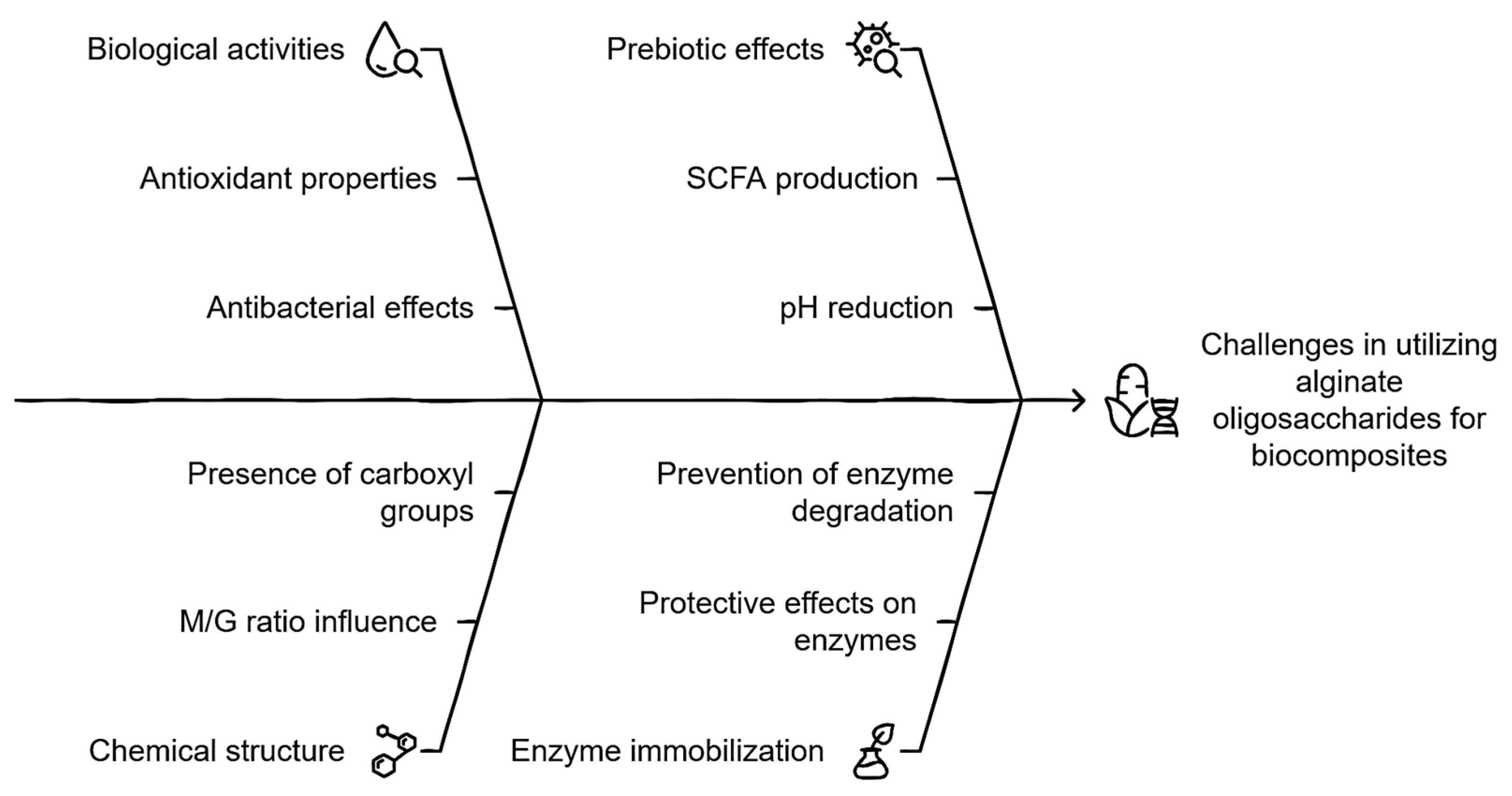
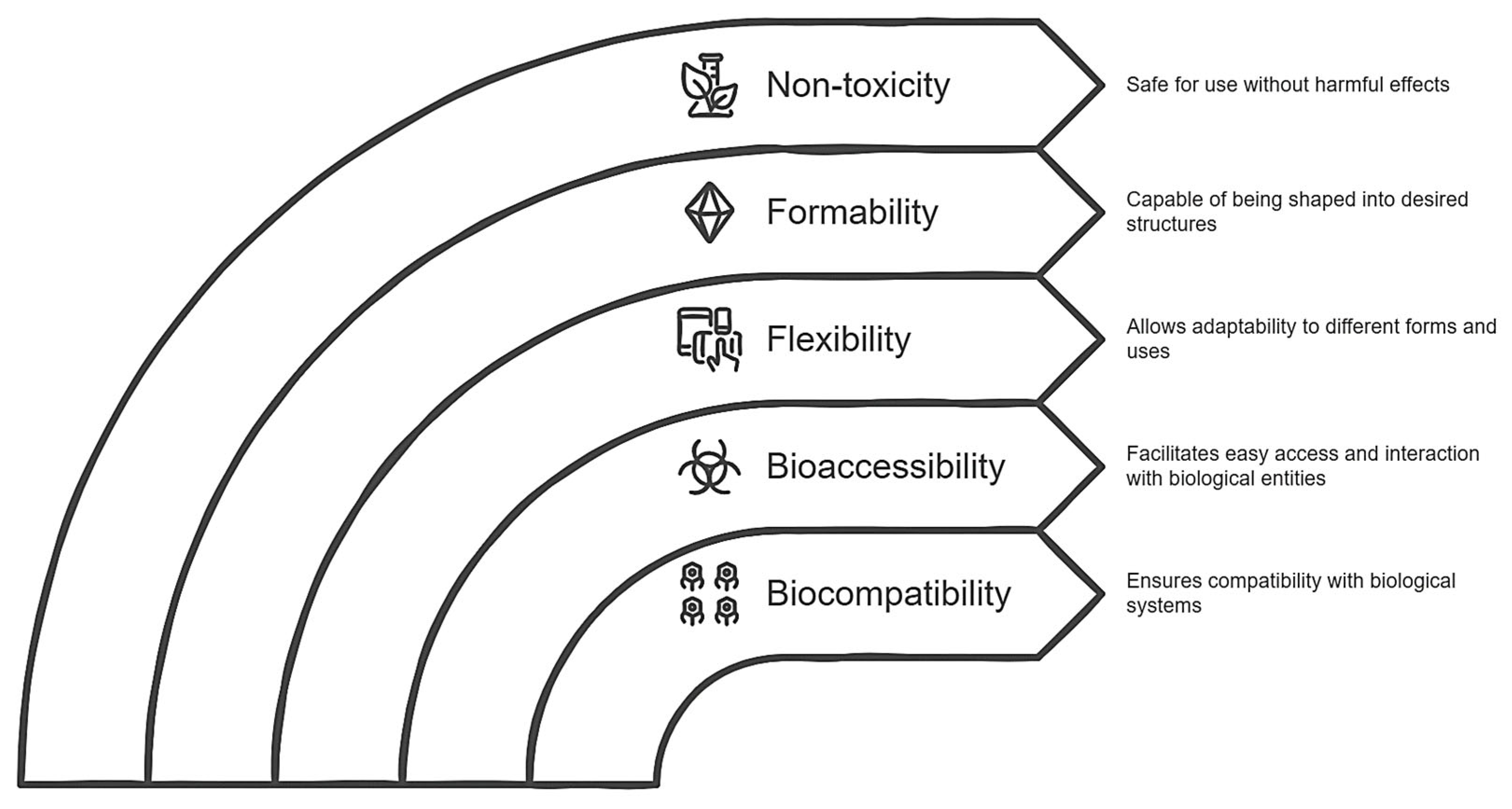
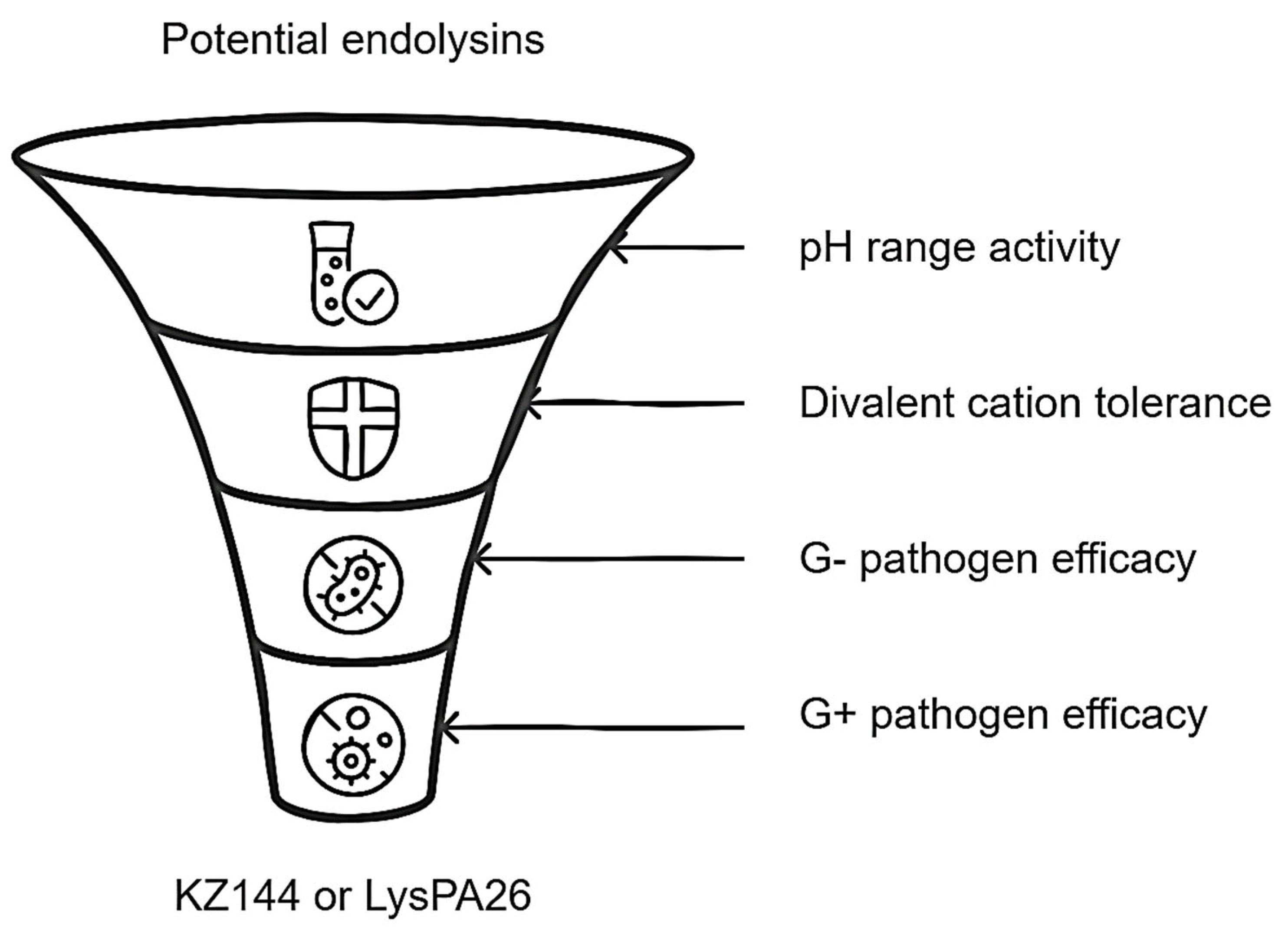
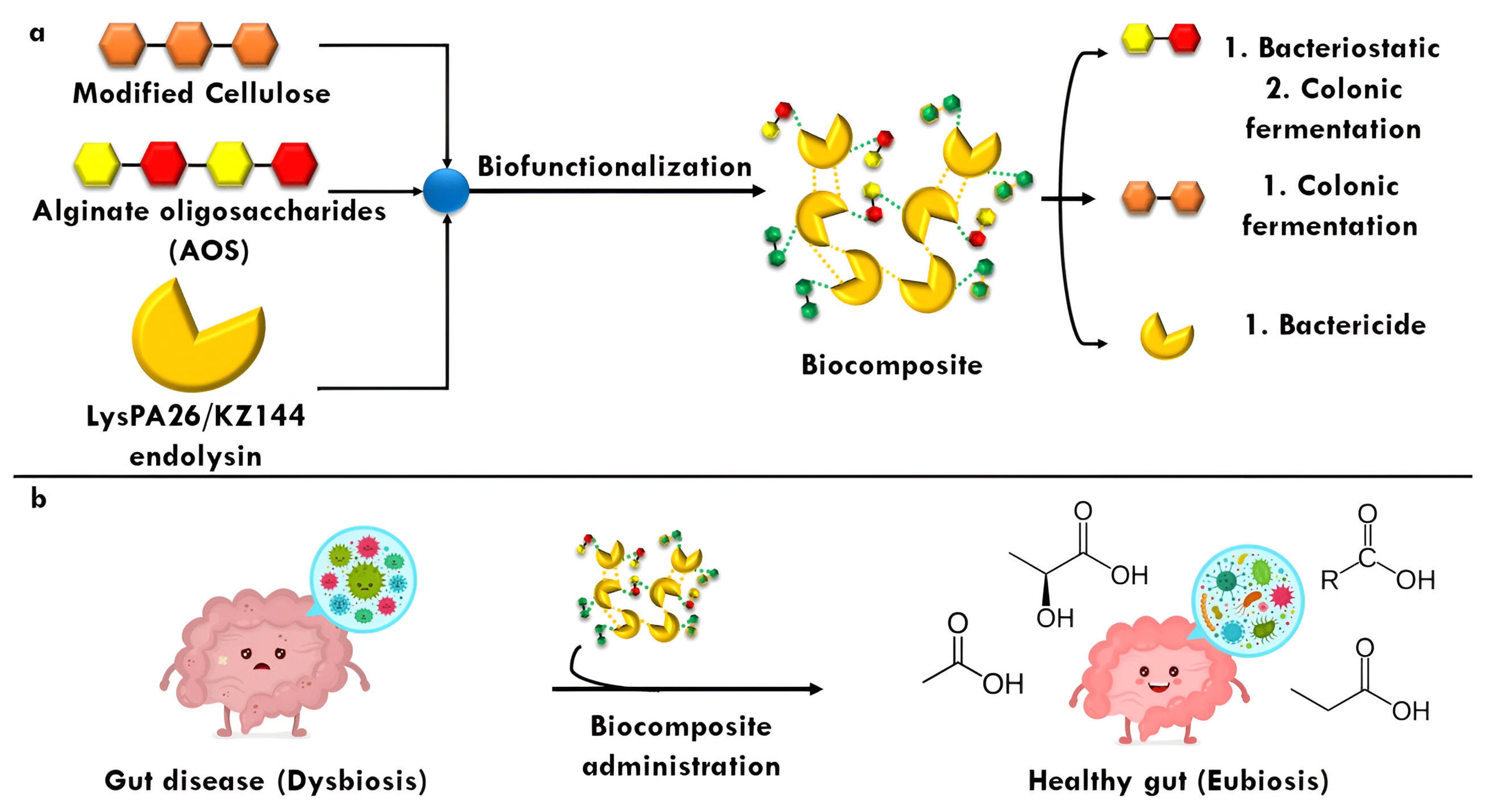
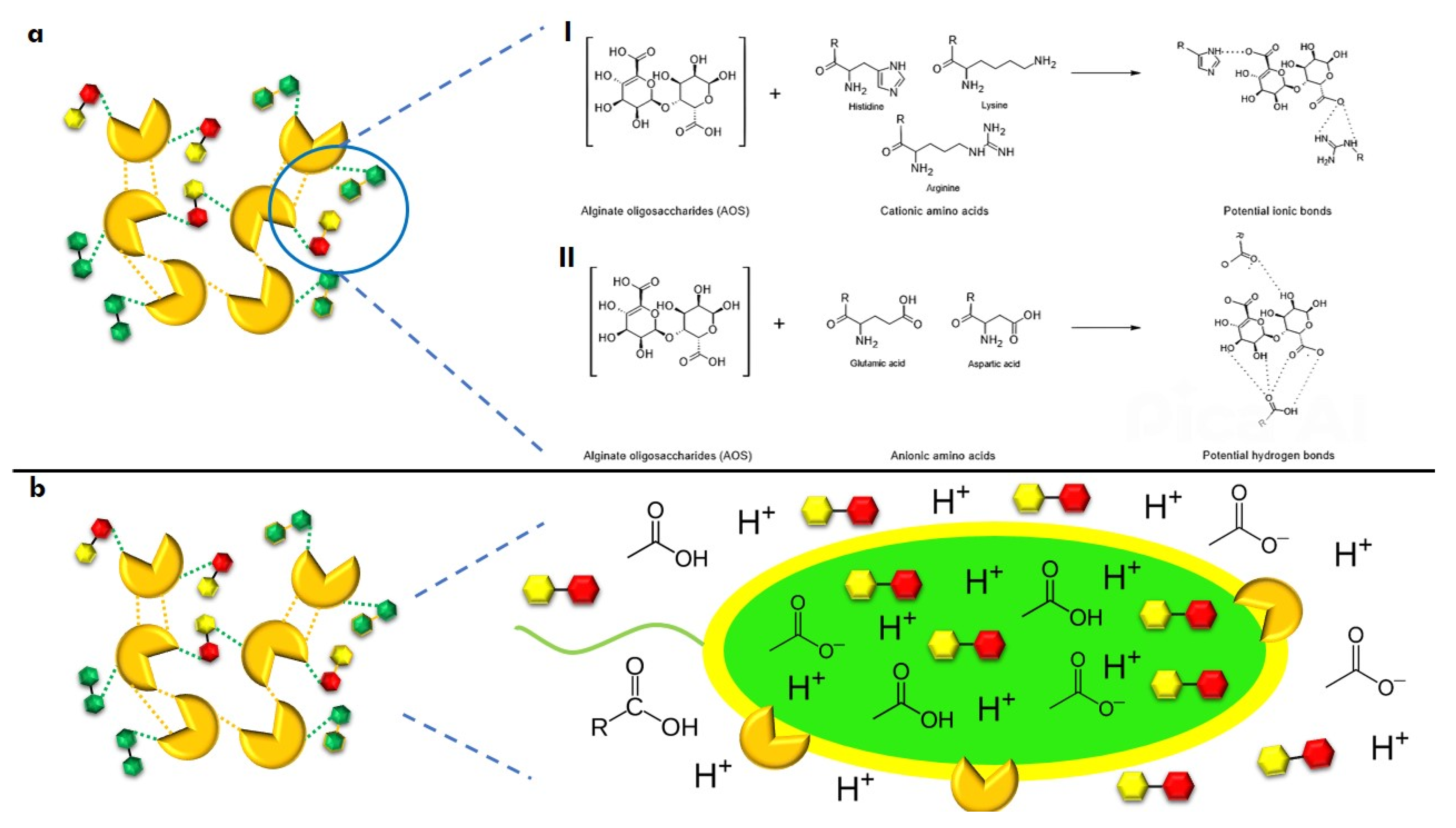

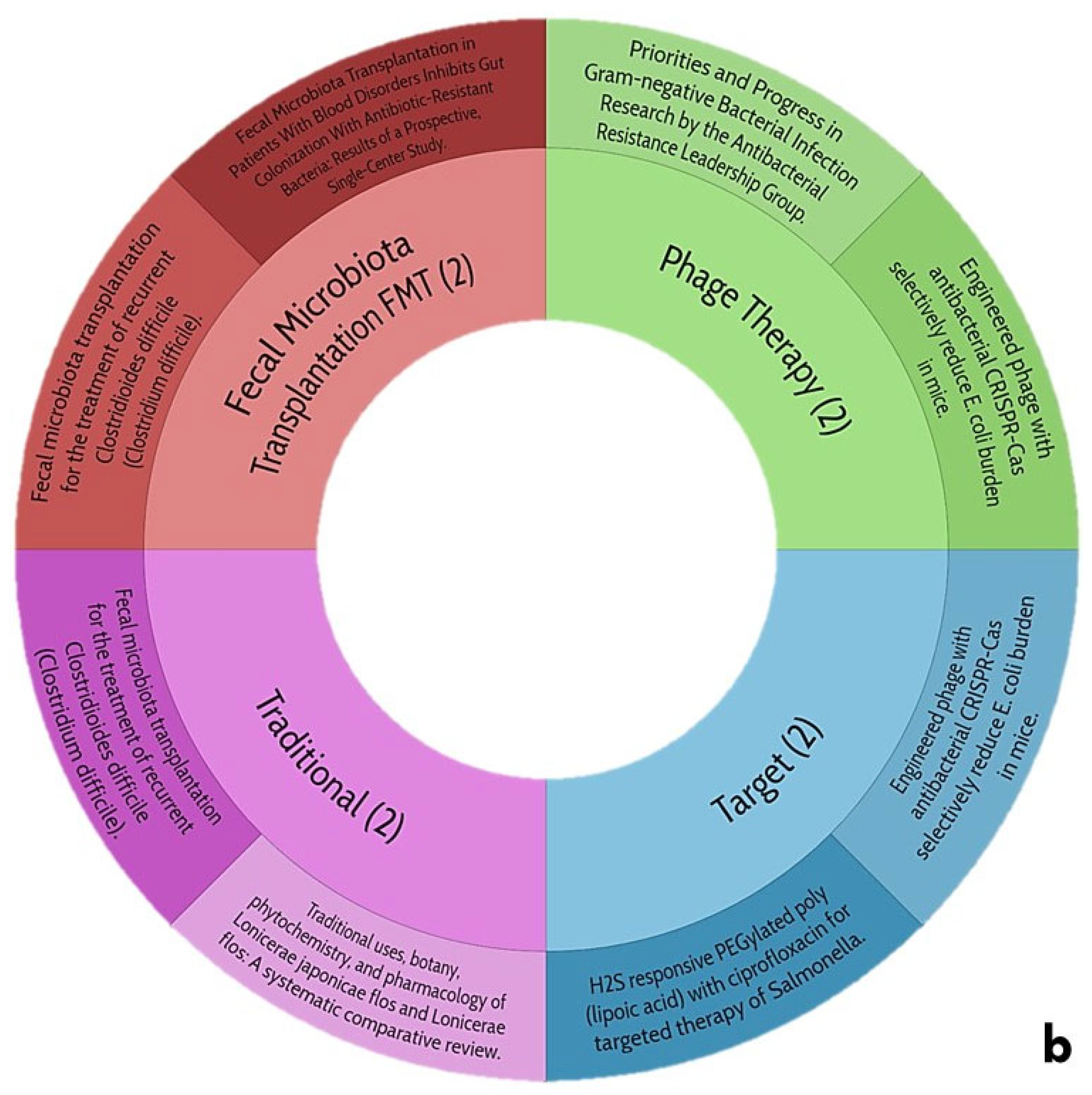

| Attributes | Disadvantages | ||
|---|---|---|---|
| Specificity | Impossibility of dysbiosis [14,15,16] | Immunogenicity | Antibodies fail to neutralize endolysins in vivo due to strong CBD binding and rapid endolysin kinetics [13,17] |
| Activity | Peptidoglycan is rapidly degraded, lysing even inactive cells [18,19] | Half-life | Fast action and strong bond may be enough [7] |
| Possible resistance | Endopeptidases cleave at cross-bridges, and triple-action EAD endolysins reduce resistance [20,21] | Proinflammation | Continuous administration (proinflammatory cytokines such as TNF-α, IL-1ß, and IFN-γ) [22,23] |
| Resensitization | Antibiotic-resistant bacteria become sensitive to antibiotics by adding endolysin [24] | Intracellular bacteria not accessible | Endolysins kill intracellular bacteria, or fusion with transduction domains enables cell uptake [20,25] |
| Endolisyn | Temperature | pH (Optimal) | Storage Details | References |
|---|---|---|---|---|
| KP27 | Stable: 50–80 °C | 2.6–10 | 10% loss of activity after 1 month storage T 4° C | [39] |
| PlyE146 | – | Negligible activity above 7 | – | [40] |
| PlyF307 | – | 6–8 (6) | – | [37] |
| KZ144 | >50 °C gradually reduces its activity (60 °C no activity) | 4.5–9 (6.2–6.5) | 4 months at 4 °C in enzymatic buffer; the activity is maintained | [14] |
| SPN9CC | Active: 24–65 °C Optimal: 50–55 °C | 6–10 (7.5–8.5) | – | [43] |
| AcLys | 50% de perdida de actividad a 37 °C en 2 h | 5–8 (6) | – | [41] |
| LysPA26 | Active: 4–100 °C Optimal: 37–50 °C | 2–10 (7–8) | – | [38] |
| Ply6A3 | Active: 22–42 °C Optimal: 32 °C | 5.5–8.5 (7.5) | – | [42] |
| LysAB2 | Stable: 20–40 °C | 4–8 (6) | – | [36] |
| Company | Identifier | Bacterial Target | Endolisin(s) |
|---|---|---|---|
| Lysando | – | Bacterial infection of the wound | Medolysin® |
| Intron Biotechnology | NCT03089697 | Staphylococcal infections | SAL200 (N-Rephasin®) |
| Micreos | NCT02840955 | Staphylococcal infections | Gladskin (Staphefekt TM XDR.300) |
| Contrafect | NCT03163446 | S. aureus bacteremia | CF-301 |
| Gangagen | NCT01746654 | S. aureus in nasal environments | P128 |
| Material | Inhibition Spectrum | Method | References |
|---|---|---|---|
| Functionalized polyurethane |
| Incubation broth (5 × 107 CFU/mL) at 37 °C for 16 h | [56] |
| Functionalized polyurethane |
| Submerged polymer incubation of 106 CFU/mL for 48 h at 37 °C | [57] |
| Functionalized silicone |
| 108 CFU/mL droplets on polymer for 3 h at 37 °C with humidity | [58] |
| Functionalized poly-lactic acid |
| Overnight cultures at 0.07 OD600, 24 h drop in contact with polymer | [59] |
| Amphiphilic polymers |
| Broth dilution method of polymer samples using MIC | [60] |
| Short Chain Fatty Acid (SCFA) | Physiological Effect | Details | References |
|---|---|---|---|
| Acetic acid (AA) | Nutritional | Obtaining energy via the Krebs cycle | [67] |
| Antinutritional | Promotes cholesterol biosynthesis due to high acetate content in serum | [67] | |
| Immunomodulator | Interacts with guanosine triphosphate (GTP) binding proteins on immune cells | [68,69] | |
| Anti-inflammatory | Decreases lipopolysaccharide (LPS)-stimulated tumor necrosis factor (TNFα) release | [68] | |
| Anticancer | Inhibits NF-κB reporter activity in human colon carcinoma | [68] | |
| Colonic function | Increases colonic blood flow | [70] | |
| Propionic acid (PA) | Nutritional | Obtaining energy via gluconeogenesis | [67] |
| Nutritional | Inhibition of cholesterol biosynthesis due to high serum propionate content | [67] | |
| Nutritional | Lowers blood glucose and alters lipid metabolism in healthy human subjects | [71] | |
| Antiinflammatory | Propionate derivatives inhibit cyclooxygenase activity, involved in the production of proinflammatory species | [72] | |
| Antiinflammatory | Inhibits LPS-stimulated TNF-α production in human neutrophils | [68] | |
| Satiety | Propionate dietary supplementation by fermentation of a dairy beverage with propionic acid bacteria increased satiety in humans | [73] | |
| Satiety | Increased production of leptin, a satiety hormone. | [74] | |
| Neurological | Propionate infusion results in altered brain phospholipid and acylcarnitine profiles | [75] | |
| Neurological | Induced neuroinflammation and oxidative stress in brain regions in rats with intraventricular infusion | [76] | |
| Colonic function | Concentration-dependent increase in the frequency of spontaneous contractions in longitudinal and circular smooth muscle of the colon | [77] | |
| Butyric acid (BA) | Nutritional | Colonocytes use butyrate as their main source of energy | [78] |
| Nutritional | Maintains normal rates of colonocyte growth and proliferation | [78] | |
| Anticancer | Inhibition of colorectal cancer cell (CRC) growth and induction of apoptosis is triggered by histone deacetylase (HDAC) inhibition | [79] | |
| Detoxifying | CRC cells treated in vitro with butyrate overexpressed enzymes involved in the defense against genotoxic and mutagenic agents, indicating a protective effect of butyrate also at the level of detoxifying enzymes | [80] | |
| Prevention of intestinal diseases (colitis) | Butyrate overproduction upregulates mucin gene expression, which protects mucosal surfaces and prevents increased cell permeability | [81] | |
| Anti-inflammatory | Reduction of the levels of proinflammatory mediators and stimulate the production of immunosuppressive cytokines | [82] | |
| Anti-inflammatory | Increased endogenous production of GLP-2 (glucagon-like peptide-2). This peptide significantly reduces the concentration of pro-inflammatory factors in the blood | [83] | |
| Immunomodulator | Decreases Interleukin-12 (IL-12) expression and increases Interleukin-10 (IL-10) production in human monocytes | [84] | |
| Anticancer | Modulation of genes associated with proliferation, differentiation, and apoptosis in colonic epithelial cells | [85] | |
| Antioxidant | In vitro modulation of oxidative and metabolic stress genes in human colon cells | [86] | |
| Satiety | Butyrate can increase the expression of peptides involved in the regulation of appetite | [87] | |
| Colonic function | Regulates enteric neurons and controls intestinal motility | [88] | |
| Insulin resistance | May reverse and prevent diet-induced insulin resistance | [89] |
Disclaimer/Publisher’s Note: The statements, opinions and data contained in all publications are solely those of the individual author(s) and contributor(s) and not of MDPI and/or the editor(s). MDPI and/or the editor(s) disclaim responsibility for any injury to people or property resulting from any ideas, methods, instructions or products referred to in the content. |
© 2025 by the authors. Licensee MDPI, Basel, Switzerland. This article is an open access article distributed under the terms and conditions of the Creative Commons Attribution (CC BY) license (https://creativecommons.org/licenses/by/4.0/).
Share and Cite
Camacho-González, C.E.; Cardona-Felix, C.S.; Pérez-Larios, A.; Zamora-Gasga, V.M.; Sáyago-Ayerdi, S.G.; Sánchez-Burgos, J.A. New Perspectives in the Fight Against Multidrug-Resistant Bacteria: The Potential of Endolysin Biocomposites. Antibiotics 2025, 14, 457. https://doi.org/10.3390/antibiotics14050457
Camacho-González CE, Cardona-Felix CS, Pérez-Larios A, Zamora-Gasga VM, Sáyago-Ayerdi SG, Sánchez-Burgos JA. New Perspectives in the Fight Against Multidrug-Resistant Bacteria: The Potential of Endolysin Biocomposites. Antibiotics. 2025; 14(5):457. https://doi.org/10.3390/antibiotics14050457
Chicago/Turabian StyleCamacho-González, Carlos E., Cesar S. Cardona-Felix, Alejandro Pérez-Larios, Víctor M. Zamora-Gasga, Sonia G. Sáyago-Ayerdi, and Jorge A. Sánchez-Burgos. 2025. "New Perspectives in the Fight Against Multidrug-Resistant Bacteria: The Potential of Endolysin Biocomposites" Antibiotics 14, no. 5: 457. https://doi.org/10.3390/antibiotics14050457
APA StyleCamacho-González, C. E., Cardona-Felix, C. S., Pérez-Larios, A., Zamora-Gasga, V. M., Sáyago-Ayerdi, S. G., & Sánchez-Burgos, J. A. (2025). New Perspectives in the Fight Against Multidrug-Resistant Bacteria: The Potential of Endolysin Biocomposites. Antibiotics, 14(5), 457. https://doi.org/10.3390/antibiotics14050457







